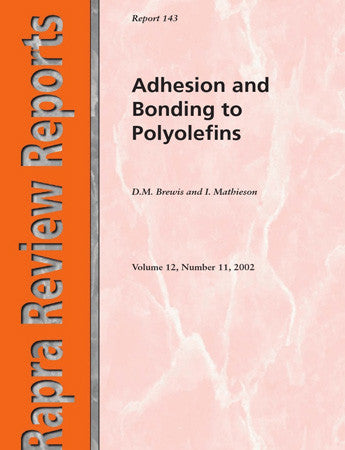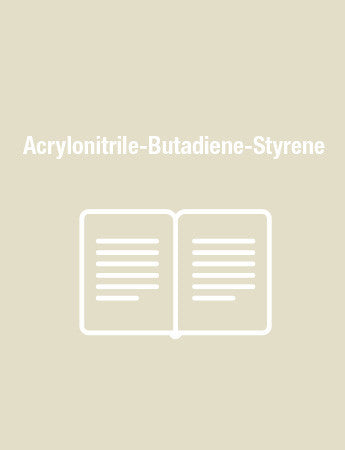Adhesion and Bonding to Polyolefins
Polyolefins have many and varied applications. Polyethylene is the most widely used plastic and olefinic elastomers, such as natural rubber and styrene-butadiene copolymers, predominate in many key components such as tires.
Many applications of polyolefins require good adhesion to other substrates such as adhesive bonding, lamination, painting, printing, and metallisation. However, polyolefins have very poor bonding properties except where a diffusion mechanism operates, such as during the welding together of two pieces of polyolefin. Theories of adhesion are briefly described.
This review discusses ways of improving adhesion to substrates. A variety of pretreatments and primers have been developed for altering the surface properties of polyolefins to enhance adhesion. These include corona discharge, flame and low-pressure plasma treatment for plastics, and the use of a chlorine donor for elastomers. Each method has advantages and disadvantages, which are discussed in this report.
A number of different analytical methods have been used to characterize the surface of polyolefins before and after treatment. These include X-ray photoelectron spectroscopy (XPS), static secondary ion mass spectrometry (SSIMS) and Fourier transfer infrared spectroscopy (FTIR). These techniques are described and examples of the information obtained are included.
Many experiments have been performed globally to investigate ways of improving the bonding of polyolefins. Data from some of the key work on different treatment methods are included, together with a discussion of the effectiveness of the treatments.
This overview is written by two of the most prominent researchers in this field. It is clearly written and will be of use to those in industry and academia who are working on adhesion and bonding to polyolefins, both in practical situations and in the laboratory.
The extensive reference section contains a unique set of abstracts from the Polymer Library at Rapra, including papers on the issues of bonding of polyolefin in composites.
Many applications of polyolefins require good adhesion to other substrates such as adhesive bonding, lamination, painting, printing, and metallisation. However, polyolefins have very poor bonding properties except where a diffusion mechanism operates, such as during the welding together of two pieces of polyolefin. Theories of adhesion are briefly described.
This review discusses ways of improving adhesion to substrates. A variety of pretreatments and primers have been developed for altering the surface properties of polyolefins to enhance adhesion. These include corona discharge, flame and low-pressure plasma treatment for plastics, and the use of a chlorine donor for elastomers. Each method has advantages and disadvantages, which are discussed in this report.
A number of different analytical methods have been used to characterize the surface of polyolefins before and after treatment. These include X-ray photoelectron spectroscopy (XPS), static secondary ion mass spectrometry (SSIMS) and Fourier transfer infrared spectroscopy (FTIR). These techniques are described and examples of the information obtained are included.
Many experiments have been performed globally to investigate ways of improving the bonding of polyolefins. Data from some of the key work on different treatment methods are included, together with a discussion of the effectiveness of the treatments.
This overview is written by two of the most prominent researchers in this field. It is clearly written and will be of use to those in industry and academia who are working on adhesion and bonding to polyolefins, both in practical situations and in the laboratory.
The extensive reference section contains a unique set of abstracts from the Polymer Library at Rapra, including papers on the issues of bonding of polyolefin in composites.
1 Introduction
2 Principles
2.1 Theories of Adhesion
2.2 Wettability
2.3 Diffusion
3 Methods Used to Study Surfaces
3.1 Introduction
3.2 X-Ray Photoelectron Spectroscopy XPS
3.3 Static Secondary Ion Mass Spectrometry
3.4 Reflection IR
4 Pretreatments and Primers for Polyolefin Plastics
4.1 Introduction
4.2 Flame Treatment
4.3 Corona Treatment
4.4 Low-Pressure Plasma Treatment
4.5 Chromic Acid Treatment
5 Polyolefin Elastomers
5.1 Introduction
5.2 Ethylene-Propylene Copolymers
5.3 Butyl Rubber
5.4 Unsaturated Hydrocarbon Elastomers
5.4.1 Natural Rubber
5.4.2 Styrene-Butadiene Copolymers
6 Discussion
7 Conclusions
References
Abbreviations and Acronyms
2 Principles
2.1 Theories of Adhesion
2.2 Wettability
2.3 Diffusion
3 Methods Used to Study Surfaces
3.1 Introduction
3.2 X-Ray Photoelectron Spectroscopy XPS
3.3 Static Secondary Ion Mass Spectrometry
3.4 Reflection IR
4 Pretreatments and Primers for Polyolefin Plastics
4.1 Introduction
4.2 Flame Treatment
4.3 Corona Treatment
4.4 Low-Pressure Plasma Treatment
4.5 Chromic Acid Treatment
5 Polyolefin Elastomers
5.1 Introduction
5.2 Ethylene-Propylene Copolymers
5.3 Butyl Rubber
5.4 Unsaturated Hydrocarbon Elastomers
5.4.1 Natural Rubber
5.4.2 Styrene-Butadiene Copolymers
6 Discussion
7 Conclusions
References
Abbreviations and Acronyms
The authors are part of the Institute for Surface Science and Technology at Loughborough University. Dr. Brewis has carried out research in the field of polyolefin adhesion over several decades and has published extensively. Dr. Mathieson has recently completed a doctoral thesis on this topic.




